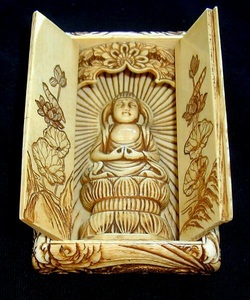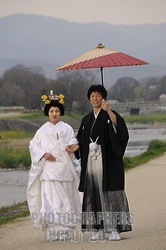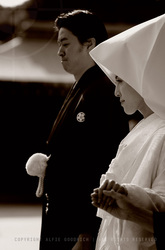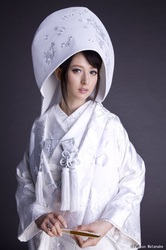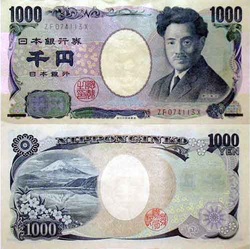Japan
Traditional Marriage Ceremony
“Today, only a third of couples in Japan marry in traditional Shinto style. Most blend the rituals of a Japanese wedding with modern Western culture. By melding the two, couples create a wedding that takes the best of both and creates their own unique day. That melding is also practiced successfully by couples in this country. ” (6)
Where to Wed?:
Many Japanese weddings take place in the spring and fall. Most weddings are held at hotels or wedding halls where chapels and shrines are conveniently located within the facilities. A Japanese wedding ceremony may be Shinto, Christian, Buddhist, or non-religious styles. Couples choose the style of their wedding ceremonies, and it doesn't necessarily match with one's religion. Non-Christian couples often have their weddings at chapels in Japan. (5) Couples will try to select a Tomobiki day on which to schedule their nuptials. Tomobiki, which means drawing friends, is considered the most auspicious day for a wedding. These days are calculated according to the ancient Japanese calendar and, because they are select dates, must be booked well in advance. (6)
In a traditional wedding, only immediate family is allowed to attend. The traditional Japanese musical accompaniment consists of flutes and is performed by artists called "ga ga ku". The marriage of two people in traditional Japanese culture is not the union between a man and a woman, but the blending of two families. The two families face each other, while the bride and groom do not. Instead, the bride and groom stand between the families and face forward, while they make an oath to keep faithful and obedient to one another.
Below:
Normal 0 false false false EN-US X-NONE X-NONE MicrosoftInternetExplorer4 /* Style Definitions */ table.MsoNormalTable {mso-style-name:"Table Normal"; mso-tstyle-rowband-size:0; mso-tstyle-colband-size:0; mso-style-noshow:yes; mso-style-priority:99; mso-style-qformat:yes; mso-style-parent:""; mso-padding-alt:0in 5.4pt 0in 5.4pt; mso-para-margin-top:0in; mso-para-margin-right:0in; mso-para-margin-bottom:10.0pt; mso-para-margin-left:0in; line-height:115%; mso-pagination:widow-orphan; font-size:11.0pt; font-family:"Calibri","sans-serif"; mso-ascii-font-family:Calibri; mso-ascii-theme-font:minor-latin; mso-hansi-font-family:Calibri; mso-hansi-theme-font:minor-latin;} http://thepetitepig.typepad.com/photos/uncategorized/dsc00410.jpg
Normal 0 false false false EN-US X-NONE X-NONE MicrosoftInternetExplorer4 /* Style Definitions */ table.MsoNormalTable {mso-style-name:"Table Normal"; mso-tstyle-rowband-size:0; mso-tstyle-colband-size:0; mso-style-noshow:yes; mso-style-priority:99; mso-style-qformat:yes; mso-style-parent:""; mso-padding-alt:0in 5.4pt 0in 5.4pt; mso-para-margin-top:0in; mso-para-margin-right:0in; mso-para-margin-bottom:10.0pt; mso-para-margin-left:0in; line-height:115%; mso-pagination:widow-orphan; font-size:11.0pt; font-family:"Calibri","sans-serif"; mso-ascii-font-family:Calibri; mso-ascii-theme-font:minor-latin; mso-hansi-font-family:Calibri; mso-hansi-theme-font:minor-latin;} http://thepetitepig.typepad.com/photos/uncategorized/dsc00410.jpg
Wedding Ceremony:
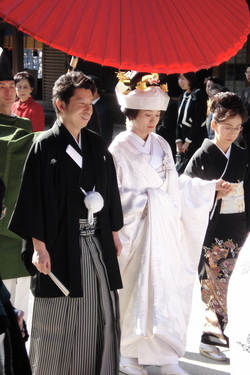
Traditional Japanese wedding ceremonies are usually Shinto-style and are held at shrines. Shinto literally means "the way of the gods." This type of religion is almost as old as Japan itself. It is Japan's major religion besides Buddhism. Shinto style weddings are held at shrines. Sometimes, shrines are located in hotels where wedding ceremonies are usually held. Shinto shrines are places of worship and considered to be the dwellings of the kami, or Shinto gods. (6) Shrines are where people go and pay their respects to the gods and pray for the gift of good fortune. They are just “logical " places to hold a wedding ceremony. In Japan today, the shine can be moved to wherever the wedding is taken place. This opens up many possibilities for the couple to choose wherever they wish to wed. It's common that only family members and close relatives of couples attend Shinto-style wedding ceremonies. A Shinto priest conducts the ceremony. A ceremony includes sake drinking rituals, exchanging wedding rings, and more. The groom reads the words of commitment. At the end of the ceremony, symbolic offerings are given to the Kami. Kami is the Japanese word for the spirits, natural forces, or essence in the Shinto faith. There are neither bridesmaids nor a best man. Traditionally, an older married couple called nakoudo (matchmaker) attends a Japanese wedding ceremony, but this tradition isn't necessary and hasn’t really been looked at for many years. The Nakoudo are responsible for managing the wedding.
The bride and groom are attended to by Miko maidens, serving sake in red and white dresses. The priest reads the wedding contract. Rice wine, called nihonshu or sake is the general Japanese terms for alcohol, which is made of rice and water and is about 20 percent alcohol. The sake, which is also served to the guests, is poured into three special cups of different sizes. The ceremony is called "SanSanKudo," which means three sets of three sips equals nine. Using the smallest of the cups, the groom takes three sips. Then the bride does the same. They do the same with the medium and large cups. At the end of the sake ceremony, both families drink a cup of sake, which represents the union of the bride and groom and unification of the two families. Drinking the wine is a sign that the marriage vows are sealed. At the close of the ceremony, symbolic offerings are given to the kami. The offerings could consist of three small twigs of Sakaki, a sacred tree. This ritual ends the ceremony.
Dress Attire:
Both the bride and the groom wear the traditional kimono for the ceremony. The bride and groom completely change their outfits three or more times during the reception. This custom dates back to the 14th century and is called "oironaoshi." It signifies the bride's preparedness to resume everyday life. The bride's traditional wedding costume is called a shiro-muku, a white silk "undergarment" that meaning literally "white pure." It is a kimono she will wear at the beginning of the ceremony. During the ceremony, she will put on other, more elaborate kimonos, over the white one. If the bride gets married in a traditional white wedding kimono, she may choose to come to the reception in a colorful embroidered kimono and if she so chooses, to change again, this time into a more modern look like a wedding dress. This is also known as western wear which means a more modern look. Putting on a kimono is not easy. Both the bride and groom have an attendant assisting them. Tying the obi, or belt, is one of the more difficult parts. Accessories are an important component in the traditional attire. They include the proper hair style, traditional socks and shoes (a tabi, short, white toe socks and zori, thonglike clogs), “underwear " and the bride carries a small purse-style sack called hakoseko and a small encased sword called kaiken. She wears a fan in her obi belt because tradition compares the widening of the open fan to happiness and so it portends a happy future. The undergarment is covered by a heavily embroidered, elaborate, richly patterned, silk brocade uchikake, or overkimono in red, white and gold. Cranes, scenes of flowers, flower carts, nature motifs and other traditional symbols of luck, health and long life are embroidered onto the fabric with gold thread. The bride will wear this kimono only once, because, in Japan, they reserved to be worn only by young, unmarried women. Red is the most popular uchikake kimono color. The bride's hair is coifed in traditional Japanese style called bunkintakashimada and is adorned with beautiful kanzashi ornaments, combs and accessories. Her wig is covered with a white hood-like veil of cloth called a tsunokakushi, meaning demon horns. It is draped over her face. According to Japanese tradition, the veil is there to hide her demon horns. The horns are a sign of jealousy and, tradition states, that by covering them, she acknowledges her submission to her mother-in-law. A white wedding hood called a literally meaning "to hide horns" is worn during the ceremony indicating that she will carry out her role as a wife with patience and serenity. The bride's face is covered with white powder (declaring her maiden status to the gods), her eyes are outlined in a dark color and her lips are painted bright red. (6)
The groom wears an outer garment (Hakama) worn over a full-length kimono, split between the legs like pants. Hakama pants originally were an outer garment designed to protect the legs of samurai warriors from brush when they were riding a horse. The hakama today is worn as formal attire for wedding ceremonies, for dances, martial arts and by artists. The traditional color of the hakama is black, gray or brown with a white pinstripe. Today pants are available in many colors to suit the bride and groom's taste. (6)
The groom wears an outer garment (Hakama) worn over a full-length kimono, split between the legs like pants. Hakama pants originally were an outer garment designed to protect the legs of samurai warriors from brush when they were riding a horse. The hakama today is worn as formal attire for wedding ceremonies, for dances, martial arts and by artists. The traditional color of the hakama is black, gray or brown with a white pinstripe. Today pants are available in many colors to suit the bride and groom's taste. (6)
http://renaisuru.wordpress.com/
http://blog.alfiegoodrich.com/index.php?showimage=385
http://www.photographersdirect.com/buyers/stockphoto.asp?imageid=2236556
http://blog.alfiegoodrich.com/index.php?showimage=385
http://www.photographersdirect.com/buyers/stockphoto.asp?imageid=2236556
How Much?:
After wedding ceremonies, wedding receptions called "kekkon hiroen" are held. The style and scale of wedding receptions vary depending on the regions. Typically, relatives, friends, co-workers, and neighbors are invited to wedding receptions. People usually dress formally to attend a Japanese wedding. Female guests wear dresses, suits, or kimono. Male guests wear black formal suits. (5) When attending a Japanese wedding reception, you are expected to bring cash for a gift. The amount depends on your relationship with the couple and the region in which you live in. Different regions vary on gifts and style of weddings. If a fixed amount is indicated in the invitation card, it is custom to bring that specific amount with you. The average is 30,000 yen for a friend's wedding. 30,000 yen in US dollars is $273.51. It's important that the cash is enclosed in a special envelope called the shugi-bukuro. Your name is written on the front. It's polite to use new bills with no creasing. When you arrive at the reception, you are supposed to hand the envelope to the person at the reception desk and sign your name in the guestbook.
Reception:
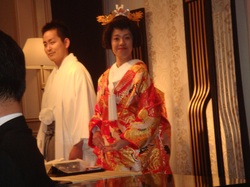
After the ceremony, a reception is held called a "Kekkon Hiroen." As few as 20 and as many as 200 or more guests may attend, which will include family, friends and business associates. During the reception, the married couple sits on a stage and enjoys the guests' speeches and performances. Many people sing congratulating songs for the couple. The couple cuts their wedding cake together and walks around the room lighting candles and greeting their guest. It's common for the bride and broom to change costumes many times during the reception. The attire worn by the bride at the reception is the most colorful aspect of the party. She wears Kanzashi, colorful ornaments, in her hair. The Uchikike gown is worn over the kimono is resplendent with ornamentation and embroidery. When she changes again, the bride will wear another kimono in a different style from the first kimono she had on. Guests are seated according to their relationship with the couple. Festivities such as games, skits, and karaoke are performed for the couple.
Wedding Souvenires:
Wedding souvenirs are called hikidemono in Japanese. They are often table wares, sweets, interiors, and more. Most recently, gift catalogs have become very popular among guest. The gift catalogs have recently become the most popular type of hikidemono. Other gifts may include beautifully wrapped traditional Japanese candies, to more “valuable" gifts like silverware, a clock, or sake to modern novelty items. The average cost of a typical Japanese wedding is said to be a couple million yen, and the number of guest range from 50 to 200 for an average couple. The average Japanese reception in Japan can run to several million yen ($20,000-$30,000), to as high as $100,000 in US dollars. The number of guest range from 50 to 200 people, on average. (6)
http://www.spoon-tamago.com/2009/06/17/michael-beirut-on-the-design-of-currency/

